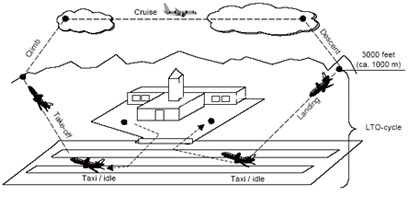Conditions relating to calculation of emissions charge in Copenhagen Airport
These conditions apply to the airlines operating in Copenhagen Airport and otherwise covered by the charge regulations
1. Introduction
1.1 Motivation and background for the emissions charge
As a result of the charge regulations (negotiations) in 2009 it was agreed between the airlines and Copenhagen Airports that an emissions-based charge would be introduced.
With the introduction of emissions charge Copenhagen Airports wants to support the use of engine types that emit the lowest emissions through financial incentives.
It is agreed between the parties that the emissions charge in the current charge period should be neutral for the airport and airlines as a total. This means that emissions charges are financed by a reduction of the current Take Off charge.
The purpose of the emissions charges is to put a greater focus on the pollution in and around the airport.
A similar emissions charge exists today in several countries including Sweden, England, Germany and Switzerland. The model introduced in Copenhagen Airport is inspired by the models that are currently found in Sweden and Switzerland.
In the year 2000, the European Aviation Industry called for harmonization of existing emission charges models. In this regard, ERLIG (Emissions Related Landing Charges Investigation Group) formed to develop a standardized model. The result of this work was a model which focused on greenhouse emissions, and this led to "the one who pollutes most, pays most." The highest emissions, the highest rate.
The most important factor in relation to pollution in and around the airports are still NOx emissions related to landing and takeoff, and that is why Copenhagen Airport wants to follow the principle around high emission, high payment. It is this model Copenhagen Airport use to calculate the emissions charge, each airline in accordance with these conditions is required to pay.
2. Description of the model
2.1 General principles
The model is based on the absolute NOx emissions of a specific aircraft engine emit in a standardized landing and take-off cycle (LTO). NOx emissions per airplane engine are based on the ICAO specifications and guidelines. The emission value is related to the absolute emission for each aircraft. Emissions charge varies linearly with emissions, which means: higher emissions, higher charge.
Source: Emission Inventory Guidebook, European Environment Agency, 2001.
ICAO collates information for different engines on emissions during the LTO and this information is used in the environment label. The engine emissions datasheets are published at: https://www.easa.europa.eu/easa-and-you/environment/icao-aircraft-engine-emissions-databank. An example datasheet is provided overleaf, with the information required to calculate CO2 and NOx emissions in the LTO highlighted.
2.2 Aircraft with Turbofan and mixed Turbofan engines
Engines with emissions data available from CPH:
Emissions Value = Number of engines * LTO NOx Emissions
2.3 Other engine types than Turbofan and mixed Turbofan
For other engine types such as turboprop, piston, helicopter, business jet, the airlines / operators have to send in information when it comes to the LTO - NOx value per engine and per aircraft registration.
Emissions Value = reported LTO NOx Emissions
2.4 Calculation of Emissions charge
Emissions Charge (DKK) = Total emissions value * unit price in DKK
3 Calculation of the unit price
It is agreed between Copenhagen Airports and the airlines that the introduction of emissions charges shall be neutral for both parties (for the airlines as a total), meaning that the parties have agreed to reduce the take off charge with an amount corresponding to the emission charge.
The unit price per kg NOx is calculated based on the total NOx emissions in 2009. There has been gathering information about Registration Numbers of aircraft and engine types, and based on this information it has been possible to calculate the total NOx emissions.
It has been decided to convert 5% of the existing take off charges (related to MTOW) to the emissions charge. Given the 5% conversion and the total NOx emissions for 2009 a unit price for emissions charge is calculated. Since it is agreed that the introduction of emissions charges shall be neutral to both parties Copenhagen Airport will during December 2010 do an evaluation of the unit price to secure the agreement of neutrality in relation to an unchanged take off charge (MTOW).
4 Overview of engine types and emissions values
4.1 Engine types - reporting
The introduction of emissions charges require that all airlines send information concerning aircraft registrations (UID No.), engine type (engine ID) and number of engines on each aircraft. This information is initially used to calculate the unit price. This information will in the future also be used for the billing of the emissions charges per take off. By each operation in the airport Copenhagen Airport receive information of aircraft registrations, so the information from the airlines will ensure a comprehensive specification of emissions charge per operation.
For missing information caused by the airlines / operators the emissions charge will be settled by using the following formula: MTOW * 0.2 (pollution factor) * unit price. The pollution factor is determined from the highest known NOx emissions to encourage the airlines / operators to send the necessary engine information to Copenhagen Airports.
If there are changes in relation to aircraft registrations and engine types, the airlines are required to report such changes. There will be no adjustment in the billing if the information from the airlines not has been correct. However, Copenhagen Airports invoke the right to make adjustments if the airport has suffered significant loss as a result of incorrect information.
4.2 Emissions values
Emissions values per engine type are based on the ICAO engine emissions databank, which contains individual engine data. The databank contains calculated emissions per engine type. Those data will be taken into account for calculation.
5 Entry into effect
These conditions will enter into effect from 31st October 2010.